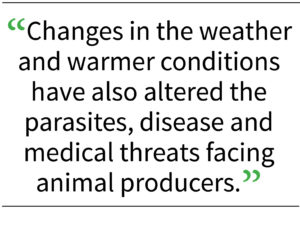Many producers house production animals in indoor, temperature controlled environments, but high summer temperatures and longer heat waves have proved costly.
By Dr. Jeanne Haggerty-Arcay

Jeanne Haggerty-Arcay
 As we begin to emerge from another historic wildfire season, climate change remains on the forefront in the scientific world. The scientific community has been integral in communicating the effects of climate change and global warming on our fire season, rising ocean levels, glacial melting and on our natural ecosystems. But there has been a lack of information conveyed to the general public in regard to its effects on global food security and the effects of climate domestically on our food supply.
As we begin to emerge from another historic wildfire season, climate change remains on the forefront in the scientific world. The scientific community has been integral in communicating the effects of climate change and global warming on our fire season, rising ocean levels, glacial melting and on our natural ecosystems. But there has been a lack of information conveyed to the general public in regard to its effects on global food security and the effects of climate domestically on our food supply.
In 2015 the USDA published an extensive study titled “Climate Change, Global Food Security, and the U.S. Food System.” The study investigated the many effects of climate change on our global food supply and our potential future as it stands. Food security was defined as “the ability to obtain and use sufficient amounts of safe and nutritious food” and has been identified as a basic human need. The study found that climate change is likely to threaten global food security “through production disruptions leading to local availability limitations and price increases, interrupted transport conduits, and diminished food safety, among other causes. The risks are greatest for the poor and in tropical regions.” But what does this really mean and how does that affect us in the United States?
The USDA has published studies and reported on the more specific effects of climate change on animal agriculture within the U.S. Climate change has effects all along the animal production chain — from feeding and raising livestock to the transportation and storage of the final animal products.
 It is well known that climate change has affected our weather. This in turn affects our ability to grow the crops necessary to produce livestock grain and hay. Pasture lands have been affected with droughts, floods and other weather changes, leading to a decline in the availability and quality of these pastures. These all mean an increase in the cost of feeding livestock and ultimately higher cost of meat.
It is well known that climate change has affected our weather. This in turn affects our ability to grow the crops necessary to produce livestock grain and hay. Pasture lands have been affected with droughts, floods and other weather changes, leading to a decline in the availability and quality of these pastures. These all mean an increase in the cost of feeding livestock and ultimately higher cost of meat.
Changes in the weather and warmer conditions have also altered the parasites, disease and medical threats facing animal producers. An animal’s core body temperature should be maintained within a 2 to 3 degree Celsius range in order to optimize production. Any deviations outside of this range affect an animal’s growth, performance and fertility.
The result is lowered meat, milk and egg production. Although many producers house production animals in indoor, temperature controlled environments, high summer temperatures and longer heat waves have proved costly. Current technologies utilized to help control an animal’s temperature have been challenged and heat-related animal deaths are increasing.
 There have been negative impacts on food safety as well. Higher temperatures mean better and more reliable technologies are constantly needed to keep up with demand and maintain our meat, eggs and milk at proper temperatures during transportation and storage. Deviations from proper storage conditions leads to spoiling and an increase in food-borne illnesses.
There have been negative impacts on food safety as well. Higher temperatures mean better and more reliable technologies are constantly needed to keep up with demand and maintain our meat, eggs and milk at proper temperatures during transportation and storage. Deviations from proper storage conditions leads to spoiling and an increase in food-borne illnesses.
The effects of climate change are visible everywhere — and our food security is no exception. Changes in climate have direct effects on production efficiency and costs associated with the transportation and storage of food. The end result is an increase in food costs and ultimately decreased availability to vulnerable populations.
Dr. Jeanne Haggerty-Arcay received her undergraduate degrees in biology, biochemistry and Spanish from the College of Notre Dame, Belmont. She graduated from U.C. Davis School of Veterinary Medicine. She enjoys spending time with her husband and three children.






